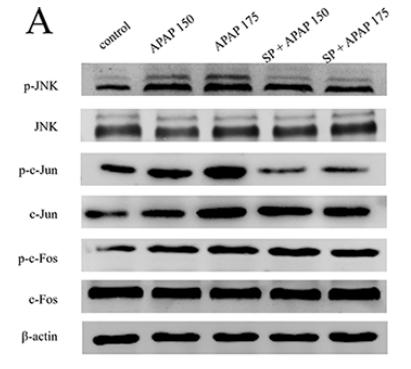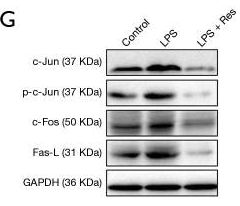c-Fos Antibody - #AF0132
| Product: | c-Fos Antibody |
| Catalog: | AF0132 |
| Description: | Rabbit polyclonal antibody to c-Fos |
| Application: | WB IHC IF/ICC |
| Reactivity: | Human, Mouse, Rat |
| Prediction: | Pig, Bovine, Horse, Rabbit, Dog, Chicken, Xenopus |
| Mol.Wt.: | 50kDa; 41kD(Calculated). |
| Uniprot: | P01100 |
| RRID: | AB_2833316 |
Related Downloads
Protocols
Product Info
*The optimal dilutions should be determined by the end user.
*Tips:
WB: For western blot detection of denatured protein samples. IHC: For immunohistochemical detection of paraffin sections (IHC-p) or frozen sections (IHC-f) of tissue samples. IF/ICC: For immunofluorescence detection of cell samples. ELISA(peptide): For ELISA detection of antigenic peptide.
Cite Format: Affinity Biosciences Cat# AF0132, RRID:AB_2833316.
Fold/Unfold
Activator protein 1; AP 1; C FOS; Cellular oncogene c fos; Cellular oncogene fos; FBJ murine osteosarcoma viral (v fos) oncogene homolog (oncogene FOS); FBJ murine osteosarcoma viral oncogene homolog; FBJ murine osteosarcoma viral v fos oncogene homolog; FBJ Osteosarcoma Virus; FOS; FOS protein; FOS_HUMAN; G0 G1 switch regulatory protein 7; G0/G1 switch regulatory protein 7; G0S7; Oncogene FOS; p55; proto oncogene c Fos; Proto oncogene protein c fos; Proto-oncogene c-Fos; v fos FBJ murine osteosarcoma viral oncogene homolog;
Immunogens
- P01100 FOS_HUMAN:
- Protein BLAST With
- NCBI/
- ExPASy/
- Uniprot
MMFSGFNADYEASSSRCSSASPAGDSLSYYHSPADSFSSMGSPVNAQDFCTDLAVSSANFIPTVTAISTSPDLQWLVQPALVSSVAPSQTRAPHPFGVPAPSAGAYSRAGVVKTMTGGRAQSIGRRGKVEQLSPEEEEKRRIRRERNKMAAAKCRNRRRELTDTLQAETDQLEDEKSALQTEIANLLKEKEKLEFILAAHRPACKIPDDLGFPEEMSVASLDLTGGLPEVATPESEEAFTLPLLNDPEPKPSVEPVKSISSMELKTEPFDDFLFPASSRPSGSETARSVPDMDLSGSFYAADWEPLHSGSLGMGPMATELEPLCTPVVTCTPSCTAYTSSFVFTYPEADSFPSCAAAHRKGSSSNEPSSDSLSSPTLLAL
Predictions
Score>80(red) has high confidence and is suggested to be used for WB detection. *The prediction model is mainly based on the alignment of immunogen sequences, the results are for reference only, not as the basis of quality assurance.
High(score>80) Medium(80>score>50) Low(score<50) No confidence
PTMs - P01100 As Substrate
| Site | PTM Type | Enzyme | Source |
|---|---|---|---|
| Y10 | Phosphorylation | Uniprot | |
| Y30 | Phosphorylation | Uniprot | |
| S32 | Phosphorylation | Q13164 (MAPK7) | Uniprot |
| S70 | Phosphorylation | Uniprot | |
| K113 | Sumoylation | Uniprot | |
| K113 | Ubiquitination | Uniprot | |
| T114 | Phosphorylation | Uniprot | |
| T116 | Phosphorylation | Uniprot | |
| K128 | Sumoylation | Uniprot | |
| S133 | Phosphorylation | Uniprot | |
| K139 | Sumoylation | Uniprot | |
| K176 | Sumoylation | Uniprot | |
| K188 | Ubiquitination | Uniprot | |
| T232 | Phosphorylation | Q13164 (MAPK7) , P27361 (MAPK3) , P28482 (MAPK1) | Uniprot |
| S258 | Phosphorylation | Uniprot | |
| S261 | Phosphorylation | Uniprot | |
| K265 | Sumoylation | Uniprot | |
| S278 | Phosphorylation | Uniprot | |
| S308 | Phosphorylation | O14920 (IKBKB) | Uniprot |
| T325 | Phosphorylation | P27361 (MAPK3) , P28482 (MAPK1) | Uniprot |
| T331 | Phosphorylation | P28482 (MAPK1) , P27361 (MAPK3) | Uniprot |
| S362 | Phosphorylation | O75676 (RPS6KA4) , Q15418 (RPS6KA1) | Uniprot |
| S363 | Phosphorylation | Uniprot | |
| S374 | Phosphorylation | P28482 (MAPK1) , P27361 (MAPK3) | Uniprot |
| T376 | Phosphorylation | Uniprot |
Research Backgrounds
Nuclear phosphoprotein which forms a tight but non-covalently linked complex with the JUN/AP-1 transcription factor. In the heterodimer, FOS and JUN/AP-1 basic regions each seems to interact with symmetrical DNA half sites. On TGF-beta activation, forms a multimeric SMAD3/SMAD4/JUN/FOS complex at the AP1/SMAD-binding site to regulate TGF-beta-mediated signaling. Has a critical function in regulating the development of cells destined to form and maintain the skeleton. It is thought to have an important role in signal transduction, cell proliferation and differentiation. In growing cells, activates phospholipid synthesis, possibly by activating CDS1 and PI4K2A. This activity requires Tyr-dephosphorylation and association with the endoplasmic reticulum.
Phosphorylated in the C-terminal upon stimulation by nerve growth factor (NGF) and epidermal growth factor (EGF). Phosphorylated, in vitro, by MAPK and RSK1. Phosphorylation on both Ser-362 and Ser-374 by MAPK1/2 and RSK1/2 leads to protein stabilization with phosphorylation on Ser-374 being the major site for protein stabilization on NGF stimulation. Phosphorylation on Ser-362 and Ser-374 primes further phosphorylations on Thr-325 and Thr-331 through promoting docking of MAPK to the DEF domain. Phosphorylation on Thr-232, induced by HA-RAS, activates the transcriptional activity and antagonizes sumoylation. Phosphorylation on Ser-362 by RSK2 in osteoblasts contributes to osteoblast transformation (By similarity).
Constitutively sumoylated with SUMO1, SUMO2 and SUMO3. Desumoylated by SENP2. Sumoylation requires heterodimerization with JUN and is enhanced by mitogen stimulation. Sumoylation inhibits the AP-1 transcriptional activity and is, itself, inhibited by Ras-activated phosphorylation on Thr-232.
In quiescent cells, the small amount of FOS present is phosphorylated at Tyr-10 and Tyr-30 by SRC. This Tyr-phosphorylated form is cytosolic. In growing cells, dephosphorylated by PTPN2. Dephosphorylation leads to the association with endoplasmic reticulum membranes and activation of phospholipid synthesis.
Nucleus. Endoplasmic reticulum. Cytoplasm>Cytosol.
Note: In quiescent cells, present in very small amounts in the cytosol. Following induction of cell growth, first localizes to the endoplasmic reticulum and only later to the nucleus. Localization at the endoplasmic reticulum requires dephosphorylation at Tyr-10 and Tyr-30.
Heterodimer; with JUN (By similarity). Interacts with MAFB (By similarity). Component of the SMAD3/SMAD4/JUN/FOS complex required for synergistic TGF-beta-mediated transcription at the AP1 promoter site. Interacts with SMAD3; the interaction is weak even on TGF-beta activation. Interacts with MAFB. Interacts with DSIPI; this interaction inhibits the binding of active AP1 to its target DNA. Interacts with CDS1 and PI4K2A (By similarity).
Belongs to the bZIP family. Fos subfamily.
Research Fields
· Cellular Processes > Cell growth and death > Apoptosis. (View pathway)
· Environmental Information Processing > Signal transduction > MAPK signaling pathway. (View pathway)
· Environmental Information Processing > Signal transduction > cAMP signaling pathway. (View pathway)
· Environmental Information Processing > Signal transduction > TNF signaling pathway. (View pathway)
· Human Diseases > Drug resistance: Antineoplastic > Endocrine resistance.
· Human Diseases > Substance dependence > Amphetamine addiction.
· Human Diseases > Infectious diseases: Bacterial > Salmonella infection.
· Human Diseases > Infectious diseases: Bacterial > Pertussis.
· Human Diseases > Infectious diseases: Parasitic > Leishmaniasis.
· Human Diseases > Infectious diseases: Parasitic > Chagas disease (American trypanosomiasis).
· Human Diseases > Infectious diseases: Viral > Hepatitis B.
· Human Diseases > Infectious diseases: Viral > HTLV-I infection.
· Human Diseases > Infectious diseases: Viral > Herpes simplex infection.
· Human Diseases > Cancers: Overview > Pathways in cancer. (View pathway)
· Human Diseases > Cancers: Specific types > Colorectal cancer. (View pathway)
· Human Diseases > Cancers: Specific types > Breast cancer. (View pathway)
· Human Diseases > Cancers: Overview > Choline metabolism in cancer. (View pathway)
· Human Diseases > Immune diseases > Rheumatoid arthritis.
· Organismal Systems > Development > Osteoclast differentiation. (View pathway)
· Organismal Systems > Immune system > Toll-like receptor signaling pathway. (View pathway)
· Organismal Systems > Immune system > IL-17 signaling pathway. (View pathway)
· Organismal Systems > Immune system > Th1 and Th2 cell differentiation. (View pathway)
· Organismal Systems > Immune system > Th17 cell differentiation. (View pathway)
· Organismal Systems > Immune system > T cell receptor signaling pathway. (View pathway)
· Organismal Systems > Immune system > B cell receptor signaling pathway. (View pathway)
· Organismal Systems > Environmental adaptation > Circadian entrainment.
· Organismal Systems > Nervous system > Cholinergic synapse.
· Organismal Systems > Nervous system > Dopaminergic synapse.
· Organismal Systems > Endocrine system > Estrogen signaling pathway. (View pathway)
· Organismal Systems > Endocrine system > Prolactin signaling pathway. (View pathway)
· Organismal Systems > Endocrine system > Oxytocin signaling pathway.
· Organismal Systems > Endocrine system > Relaxin signaling pathway.
References
Application: WB Species: Mouse Sample:
Application: WB Species: mouse Sample: liver
Application: IF/ICC Species: Human Sample: ovarian granulosa cells
Application: IF/ICC Species: rat Sample: ovarian granulosa cells
Application: WB Species: Sample: RAW264.7 cells
Application: WB Species: Mice Sample: RAW264.7 cells
Application: WB Species: rat Sample: spinal cord
Application: IF/ICC Species: rat Sample: activated neurons, astrocytes, and microglia
Application: WB Species: Rat Sample: lung tissue
Restrictive clause
Affinity Biosciences tests all products strictly. Citations are provided as a resource for additional applications that have not been validated by Affinity Biosciences. Please choose the appropriate format for each application and consult Materials and Methods sections for additional details about the use of any product in these publications.
For Research Use Only.
Not for use in diagnostic or therapeutic procedures. Not for resale. Not for distribution without written consent. Affinity Biosciences will not be held responsible for patent infringement or other violations that may occur with the use of our products. Affinity Biosciences, Affinity Biosciences Logo and all other trademarks are the property of Affinity Biosciences LTD.









